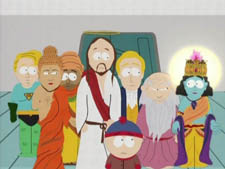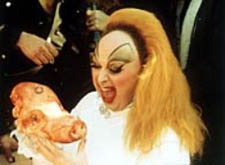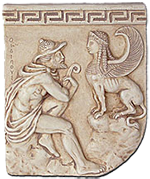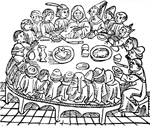

 | ||||
|
(Dimitriadis & Kamberelis, 2006, p.54) |
||||
 |
 |
 | |||
| This temporary suspension, both ideal and real, of hierarchical rank created
during carnival time a special type of communication impossible in everyday
life. This led to the creation of special forms of marketplace speech and
gesture, frank and free, permitting no distance between. (Bakhtin, 1965/1984, p. 199) |
||||
 | ||||
 Art forms can also be carnivalesque, too. Satire that questions or mocks cultural and political establishments can be said to be carnivalesque.
Art forms can also be carnivalesque, too. Satire that questions or mocks cultural and political establishments can be said to be carnivalesque.Also, art that questions taste through excessive vulgarity is carnivalesque. Rabelais, Chaucer, Shakespeare, and Cervantes, among others often included overt eating, drinking, defecating, and sex, as part of a 'rehabilitation of the flesh' in response to the ascetic middle ages. (Bakhtin, 1965/1975, p. 204) 
|
||||
 |
 |
 | |||
|
But we are especially interested in the language which mocks
and insults the deity and which was part of the ancient comic cults. These
abuses were ambivalent: while humiliating and mortifying they at the same
time revived and renewed. (Bakhtin, 1965/1984, p. 203) [T]he so-called parodia sacra, 'sacred parody', [is] one of the most peculiar and least understood manifestations of medieval literature. There is a considerable number of parodical liturgies ('The Liturgy of the Drunkards', 'The Liturgy of the Gamblers'), parodies of Gospel readings, of the most sacred prayers (the Lord's Prayer, the Ave Maria), of litanies, hymns, psalms, and even Gospel sayings. ... All of it was consecrated by tradition and, to a certain extent, tolerated by the Church. It was created and preserved under the auspices of the 'Paschal laughter', or of the 'Christmas laughter'; it was in part directly linked, as in the parodies of liturgies and prayers, withe the 'feast of fools' and may have been performed during this celebration. (Bakhtin, 1965/1984, p. 203) |
||||
 | ||||
|
So the carnivalesque manifests itself in satire and parody, and in the vulgar and informal genres of speech that fly freely when rules and bounds are suspended. Does it relate to other literary genres? |
||||
 |
 |
 | |||
|
Speaking somewhat too simplistically and schematically, one could say that
the novelistic genre has three fundamental roots: the epic, the rhetorical, and
the carnivalistic. It is in
the realm of the serio-comical that one must seek the starting points of development
for the diverse varieties of the third, that is the carnivalistic, line of
the novel, including that variety which leads to Dostoevsky. (Bakhtin, 1963/1984, p. 188) The destruction of epic distance and the transferral of the image of an individual from the distanced plane to the zone of contact with the inconclusive events of the present (and consequently of the future) result in a radical restructuring of the image of the individual in the novel - and consequently in all literature. Folklore and popular-comic sources for the novel played a huge role in this process. Its first and essential step was the comic familiarization of the image of man. Laughter destroyed epic distance; it began to investigate man freely and familiarly, to turn him inside out, expose the disparity between his surface and his center, between his potential and his reality. (Bakhtin, 1941/1981, p. 35) |
||||
 | ||||
 So there was a movement from the epic poetic genres, which were monologic and finalized, where the perspective of the author was greater than that of the heroes, and the fates of the heroes were for the formal and thematic edification of the author and audience, rather than the character (Bakhtin, 1941/1981). These genres inhabited a 'time-space' (or chronotope') dubbed 'adventure-time' by Bakhtin (1937/1981) where causation does not apply, time does not pass, and events occur fortuitously at the whim of the author. So there was a movement from the epic poetic genres, which were monologic and finalized, where the perspective of the author was greater than that of the heroes, and the fates of the heroes were for the formal and thematic edification of the author and audience, rather than the character (Bakhtin, 1941/1981). These genres inhabited a 'time-space' (or chronotope') dubbed 'adventure-time' by Bakhtin (1937/1981) where causation does not apply, time does not pass, and events occur fortuitously at the whim of the author. The influence of the voices of the primary, more immediate and carnivalesque, folk traditions and genres influenced narrative forms, making the novel a polyphonic, carnivalesque interaction of multiple voices.
The influence of the voices of the primary, more immediate and carnivalesque, folk traditions and genres influenced narrative forms, making the novel a polyphonic, carnivalesque interaction of multiple voices. |
||||
 |

Ayers, W., & Alexander-Tanner, R. (2010). To teach: The journey, in comics. New York, NY: Teachers College Press.
Bakhtin, M. M. (1981). Discourse in the novel (C. Emerson & M. Holquist, Trans.). In M. Holquist (Ed.), The dialogic imagination: Four essays by Mikhail Bakhtin (pp. 259-422). Austin, TX: University of Texas Press. (Original work published 1975).
Bakhtin, M. M. (1981). Epic and Novel (C. Emerson & M. Holquist, Trans.). In M. Holquist (Ed.), The dialogic imagination: Four essays by Mikhail Bakhtin (pp. 3-40). Austin, TX: University of Texas Press. (Original work published 1941).
Bakhtin, M. M. (1981). Forms of time and of the chronotope in the novel (C. Emerson & M. Holquist, Trans.). In M. Holquist (Ed.), The dialogic imagination: Four essays by Mikhail Bakhtin (pp. 84-258). Austin, TX: University of Texas Press. (Original work published 1937).
Bakhtin, M. M. (1984). From Rabelais and his world (H. lswolsky, Trans.). In P. Morris (Ed.), The Bakhtin reader (pp. 195-244). New York, NY: Oxford University Press. (Original work published 1965).
Bakhtin, M. M. (1984). Problems of dostoevsky's poetics. (C. Emerson, Trans.). Minneapolis, MN: University of Minnesota Press. (Original work published in 1963).
Bakhtin, M. M. (1986). From speech genres and other late essays (H. lswolsky, Trans.). In P. Morris (Ed.), The Bakhtin reader (pp. 81-87). New York, NY: Oxford University Press. (Original work published 1976).
Cuenca, A. (2010). Democratic means for democratic ends: The possibilities of Bakhtin's dialogic pedagogy for social studies. The Social Studies, 102(1), 42-48.
Dimitriadis, G., & Kamberelis, G. (2006). Theory for education. New York, NY: Routledge.
Miles, A. P. (2010). Dialogic encounters as art education. Studies in art education: A journal of issues and research 51(4), 375-379.
Roberts, G. (1994). A glossary of key terms. In P. Morris (Ed.), The Bakhtin reader (pp. 245-252). New York, NY: Oxford University Press.
Rule, P. (2011). Bakhtin and Freire: Dialogue, dialectic and boundary learning. Educational philosophy and theory 43(9), 924-942.